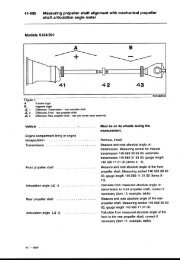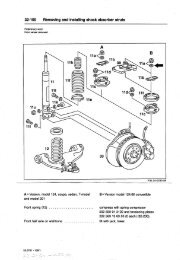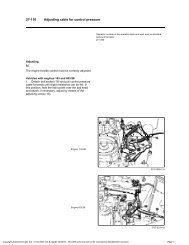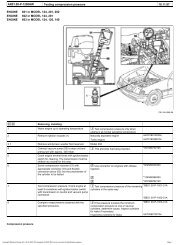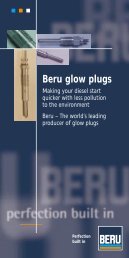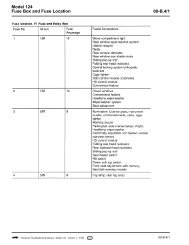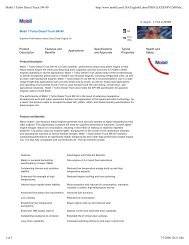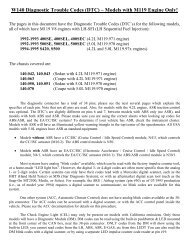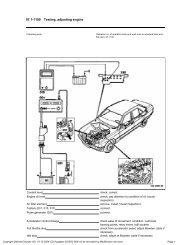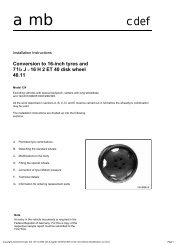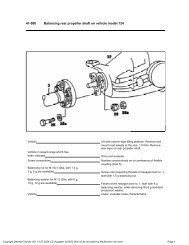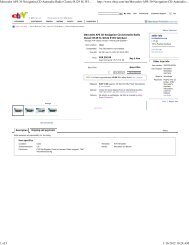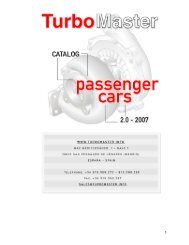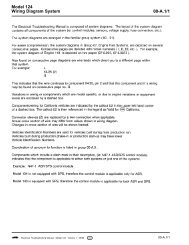MULTILINK SUSPENSIONS - W124 Performance
MULTILINK SUSPENSIONS - W124 Performance
MULTILINK SUSPENSIONS - W124 Performance
Create successful ePaper yourself
Turn your PDF publications into a flip-book with our unique Google optimized e-Paper software.
FEATUREARTICLE<br />
<strong>MULTILINK</strong><br />
<strong>SUSPENSIONS</strong><br />
How to discern, diagnose and<br />
repair suspension problems<br />
when they occur. . .<br />
14
Almost all Mercedes-Benz cars built since the<br />
middle 1980’s have used similar suspension geometry,<br />
particularly for the rear suspension. This geometry,<br />
beginning with models 201 and 124, is among<br />
the simplest and most successful of all multilink<br />
suspensions (though perhaps it is odd to describe<br />
any multilink suspension as simple). Here we’ll<br />
look at why the design is used, at how it works and<br />
how to discern, diagnose and repair problems when<br />
they occur.<br />
Independent and Multilink<br />
Automotive applications of leaf springs achieved a<br />
much higher level of success. In fact, for carrying<br />
very heavy loads even today large trucks almost uniformly<br />
use either solid axles and leaf springs or, to<br />
attune suspensions to load, solid axles with variablepressure<br />
airbag springs. Cars, however, seldom<br />
carry loads several times the vehicle’s empty weight;<br />
and we expect not only a more comfortable ride, but<br />
optimized traction and directional control as well.<br />
Hence modern passenger vehicles generally use<br />
independent suspensions and coil springs. Such<br />
arrangements eliminate the effect one wheel bouncing<br />
on an axle can have on the opposite side, reduce<br />
the unsprung weight (wheels and tires, brakes and<br />
axles, everything that rests on the ground side of the<br />
springs) to a minimum, so the road-induced oscillations<br />
of the suspension itself affects the passenger<br />
compartment as little as possible.<br />
First, let’s glance over the reasons for independent<br />
multilink suspension so we understand what it’s<br />
supposed to do. The original vehicle suspensions<br />
were on oxcarts, with solid axles bolted solidly to the<br />
wagon they supported. If you really want to ‘feel the<br />
road,’ you can’t beat a solid, unsprung axle: You’ll<br />
get feedback from every twig and pebble; if you drive<br />
over a coin, you’ll know whether it was heads or<br />
tails. At any speed, you’ll get compression damage to<br />
your spine and coccyx, too. This impact is not only<br />
uncomfortable for the driver, it quickly destroys the<br />
vehicle and its load, too, unless it’s heavy and overbuilt<br />
or moves so slowly the road-slams linger over<br />
time. Roman centurions stood rather than sat in<br />
their war chariots not just because they were macho<br />
and studly, but also because that let them bend their<br />
knees to accommodate the jolts and lurches of the<br />
unsprung vehicle. Riders of stiff-sprung motorcycles<br />
today stand on the footpegs while crossing railroad<br />
tracks for the same reason.<br />
Leaf springs, mounted either longitudinally or laterally,<br />
were a great improvement over that. With<br />
enough suspension travel, they could allow the vehicle<br />
to traverse very rough surfaces with at least fewer<br />
hard slams against the frame itself. Pioneers traveling<br />
in Conestoga wagons, however, preferred to walk<br />
alongside, and not just to relieve the horses of some<br />
load – walking was more comfortable than riding.<br />
Multilink suspensions ratchet the handling objectives<br />
up in a new way. Not only do we want a<br />
smoother ride, with less bumping and lurching; we<br />
also want better performance and safety. An optimized<br />
independent suspension can reduce the perceived<br />
inertial effect of bumps, but it does not automatically<br />
optimize traction and control. If you think<br />
about it for a moment, the only reason a Roman<br />
chariot had any traction or control at all was because<br />
the centurion’s horses had independent, multilink<br />
suspensions (and because horses are heavier than<br />
chariots with centurions).<br />
Optimized Wheel Position<br />
For any vehicle, for any load and for any combination<br />
of speed and radius in a turn, there is a unique,<br />
optimal position for each wheel and tire with respect<br />
to the pavement. This position maximizes the treadpatch<br />
contact area with the pavement and sustains a<br />
predictable and continuous influence on the directional<br />
control of the car.<br />
15
MUTILINK<strong>SUSPENSIONS</strong><br />
16<br />
While you can predict some of these positions<br />
(we’ll surely want the wheels pointing straight<br />
ahead and angled perpendicular to the pavement<br />
when driving in a straight line), determining most of<br />
the others requires extensive testing and experiment.<br />
For example, you want the rear outside wheel<br />
to gradually angle inward, to toe inward, as the vehicle<br />
leans to that side in an increasingly steep turn.<br />
You want this because the contact patch in a turn<br />
does not move parallel to the centerline of the wheel,<br />
but gradually angles inboard as the turn steepens,<br />
up to the point when traction goes away. This keeps<br />
the turning angle of the vehicle kinetically or tactually<br />
predictable to the driver. However, you don’t<br />
want that toe change to continue up to the point<br />
when the vehicle suddenly spins. Rear wheel traction<br />
must always exceed front wheel traction for<br />
obvious reasons of safety.<br />
Similarly, most cars corner somewhat better if the<br />
outside wheels pick up a few degrees of negative<br />
camber in a turn, to offset the effect of the tilting tire<br />
sidewalls. Engineers specify the dynamic suspension<br />
angles like caster only after extensive research.<br />
When you do your first Mercedes-Benz alignment,<br />
you’ll be surprised at the specified caster angle if<br />
you learned alignment on domestic vehicles. Some<br />
of the older models called for as much as 12 degrees<br />
positive. The higher speeds at which people drive in<br />
Germany require a much larger caster angle than is<br />
common here to ratchet the steering stability high<br />
enough for those speeds.<br />
Traction in turns is not the only objective of multilink<br />
design. With careful design of the geometry, the<br />
front suspension can resist dips under braking, and<br />
the rear can resist dips under acceleration. Braking<br />
and acceleration forces also raise the suspension<br />
with a force proportional to the acceleration change<br />
by the twisting effect they have on the knuckle.<br />
Keeping the suspension height level keeps the tiretread<br />
geometry straight and square with the road<br />
under both acceleration and braking, optimizing<br />
traction for both. An anti-dive suspension, in other<br />
words, can actually reduce braking distance since it<br />
keeps the tiretread flat against the pavement.<br />
Similarly, antisquat rear-suspension geometry can<br />
improve traction for acceleration. In each case, the<br />
height correction maintains the camber on that axle<br />
constant. Finally, the right multilink geometry allows<br />
the effective employment of truly effective, active<br />
suspension systems taking the control of traction<br />
and handling to yet a new level (largely quick-adjusting<br />
dampers, but also some height adjustment).<br />
Rear Suspension<br />
Enough for the theory and the objectives, let’s look<br />
at the parts on the car. The rear suspensions of all<br />
current Mercedes-Benz cars share the same five-link<br />
geometry. The parts, to be sure, are not interchangeable<br />
between models, but the geometry is, as we<br />
learned in high school, congruent.<br />
The five links are:<br />
Spring Link<br />
This is the lowest and largest link in the suspension,<br />
pivoted inboard at the differential/rear axle subframe<br />
and outboard where it forms a yoke with the<br />
knuckle of the axle. A bit inboard of the center of the<br />
link is the cavity for the bottom of the coil spring,<br />
the cavity that gives the link its name. A protective<br />
cover bolts to the underside of the spring link, fending<br />
off road debris. That protective cover also works<br />
as a reliable indicator if there has been collision<br />
damage: Since it is the lowest part of the suspension,<br />
it is the most likely to encounter an obstacle, and<br />
being lighter it will bend or crack before the spring<br />
link will.
Camber Link<br />
Pulling Link<br />
Connecting the forward top part of the knuckle,<br />
immediately adjacent to the outboard end of the<br />
camber link, to the upper, forward part of the subframe,<br />
the pulling link transmits braking force as<br />
well as holding the knuckle vertically steady.<br />
Secondary Components<br />
Directly above the driveaxle and the spring link is<br />
the camber link, connecting the upper part of the<br />
subframe to the upper part of the knuckle. Its function<br />
is to keep the tire vertical with respect to the<br />
pavement as the vehicle corners or leans.<br />
Tie Link<br />
The shortest of the five links extends from an arm on<br />
the knuckle to a flange at the front of the rear subframe.<br />
This link controls the rear toe and thrust line.<br />
You make adjustments at the eccentric bushing at<br />
the front of the link.<br />
Pushing Link<br />
The swaybar and its bushings are above the drive<br />
axle but connect through the yoke at the outboard<br />
side of the spring link to the knuckle. Most<br />
Mercedes-Benz technical literature refers to the<br />
swaybar as a “torsion bar.” The driveshafts themselves<br />
are also, in a way, links between the differential<br />
and the wheels.<br />
Front Suspension<br />
Running forward from the lowest part of the knuckle<br />
to the subframe, the pushing link transmits the<br />
drive forces from the knuckle forward to the body of<br />
the car. When the driver accelerates, the final, delivered<br />
engine torque applies to the vehicle mostly<br />
through the pushing link.<br />
The current Mercedes-Benz front suspension looks<br />
simpler than the rear, though there are several variations.<br />
All share a lower wishbone with the damper<br />
strut as far outboard as is compatible with clearing<br />
the wheel and tire. The springs are as far inboard as<br />
possible to reduce their share of the unsprung<br />
weight. You make the alignment adjustments<br />
through eccentric inboard bushings and at the<br />
tierod ends. The swaybar extends across the front of<br />
the suspension.<br />
17
MUTILINK<strong>SUSPENSIONS</strong><br />
The suspension does not support the body of the<br />
car directly. In each Mercedes-Benz, the suspension<br />
connects to a subframe through hard-rubber bushings,<br />
which in turn supports the body through other<br />
hard-rubber bushings. Much of the vehicles’ quiet<br />
running comes from this suspension and drivetrain<br />
bushing design. The engine and drivetrain also rest<br />
on the subframes on a third set of hard-rubber<br />
blocks, and this separation of the body from the suspension<br />
and drivetrain and their isolation from one<br />
another reduces the transmission of vibrations from<br />
the engine and from the road. Rubber and<br />
rubber/antifreeze bushings hold the major components<br />
at an effective, vibration-damping setoff. The<br />
antifreeze retains the advantages of liquid damping<br />
when temperatures fall below freezing.<br />
18<br />
Certain models, beginning with the 140, use a<br />
small control arm at the top of the damper strut to<br />
better optimize caster and camber in certain driving<br />
modes. Some experienced mechanics find the angle<br />
of that small control arm is the quickest indication<br />
of any problem with suspension height, such as sagging<br />
springs. It pivots back as well as up in its normal<br />
travel, so once you’ve seen a few ‘known-good’s’<br />
one that’s out of adjustment will leap out at you.<br />
Alignment procedures<br />
The linkage geometry may be complex, but adjustment<br />
procedures generally are not. You set caster<br />
and camber, front and rear, with the eccentrics<br />
(changing both at the same time!). Then you set the<br />
rear toe with the eccentric on the tie link, and once<br />
the thrust line is correct, set the front toe with the<br />
adjustable tierods.. If an eccentric adjustment can’t<br />
bring the system into specification, something is<br />
either worn beyond use or broken. Damaged struts<br />
are visible by comparison to the mirror-image strut<br />
on the other side; worn bushings will be visibly different<br />
from the others. Oil and heat damage should<br />
be evident to an experienced eye.<br />
Subframes<br />
The rear suspension shares the same indirect connection<br />
to the body through a bushed subframe. The<br />
rear subframe supports the body, but it also supports<br />
the differential with separate rubber bushings.<br />
The suspension links attach to the same subframe in<br />
several positions, as we’ll see below.<br />
Critical as the subframes are, you should inspect<br />
them carefully for damage, especially for cracks,<br />
which can sometimes close up and hide when the<br />
weight is off the wheels. Rustproofing and accumulated<br />
dirt can conceal such cracks. Ball joints are<br />
subject to normal wear. Mercedes-Benz carries a<br />
simple go/no-go gauge to test them.<br />
Sometimes people decide to add their own ‘edge’<br />
to the alignment specifications to give a car a particular<br />
ride, by tweaking the front camber and the<br />
like. This is not a particularly good idea with<br />
Mercedes-Benz cars. The company does a great deal<br />
of research in handling and suspension, and their<br />
German domestic customers expect the cars to drive<br />
in control even at high speeds and under challenging<br />
road conditions. Unless your customer weighs<br />
400 pounds and always rides alone or is an anvil<br />
peddler with a trunk full of samples, you should<br />
probably stick with the book settings.
There are a large number of accessories that, on<br />
one model or the other, connect to different suspension<br />
links and components. Some are as familiar as<br />
ABS wheelspeed sensors; some are as unusual as<br />
the switch on the 129 (SL) rear linkage that triggers<br />
the roll bar up if the rear wheels leave the ground.<br />
Many Mercedes-Benz cars have different forms of<br />
active suspension (varying the shock damper rates),<br />
suspension height adjustment (some cars crouch<br />
down an inch or so closer to the highway for better<br />
aerodynamics at high speeds), sensors for locking<br />
differentials and more. If you find such a component<br />
in your way, determine what it is and how to remove<br />
it without causing unexpected problems later. In<br />
subsequent articles and issues, we’ll get to all the<br />
Mercedes-Benz vehicle systems, but for now we’re<br />
just looking at the multilink suspension basic<br />
geometry.<br />
There are several other safety-related issues:<br />
Many Mercedes-Benz vehicles have diagonal crossbraces<br />
below the floor, particularly roadsters and<br />
convertibles. These function to keep the body stiff<br />
and square under driving stresses. Be sure you have<br />
the body supported equally and level at the designated<br />
jacking points before you remove these crossbraces.<br />
If not, there could be body damage in some<br />
other area of the car, and you may find it very difficult<br />
to get the cross-braces and their fastener bolts<br />
back into the right positions.<br />
That applies to potential damage to the vehicle.<br />
This applies, in addition, to potential personal<br />
injury. Remember, only the damper struts hold the<br />
springs in place on these suspensions, when the car<br />
is on a lift and the suspension is at full extension.<br />
The front geometry vaguely resembles a<br />
MacPherson strut, but that’s not what it is. If you<br />
remove the damper strut without restraining the<br />
spring in a spring compressor, the spring can fly out<br />
of the seat with unexpectedly great force. Mercedes-<br />
Benz dealers carry spring compressors and modelspecific<br />
end flanges that make this critical step safe<br />
and easy.<br />
Finally, here’s a general precaution that doesn’t<br />
apply to vehicle or personal safety, but could make<br />
the difference between a satisfactory job and one<br />
you have to do over free. Multilink suspensions<br />
include a large number of bushings, at least one at<br />
either end of each link. Many of these links are<br />
clock-position specific, and many such specific clock<br />
positions are very easy to confuse with others for<br />
similar vehicles. For instance, suppose you’re<br />
replacing front control arm bushings on a 201 and<br />
using the clamping sleeve replacement bushing. On<br />
the forward front control arm bushing, the flat spots<br />
in the bushing go vertical [position for line drawing<br />
P33-2053-13] and the rear flats go horizontal, toward<br />
the center of the car. On a 124 or 129, however, you<br />
put the rubber flats vertical on the rear pivot of the<br />
control arm, and turn the front bushing flats horizontal<br />
toward the center of the car, just the opposite<br />
of what you do on the 201.<br />
Now, nobody can remember all this accurately.<br />
That’s why we have reference materials and technical<br />
libraries. The point is, when you see a Mercedes-<br />
Benz bushing that is not perfectly symmetrical in<br />
every orientation, that means there is one correct<br />
and many incorrect ways to install it. Failing to find<br />
and observe that right orientation means the bushing<br />
will have a different and unpredictable elasticity<br />
than the engineers designed for that linkage pivot.<br />
The car will drive measurably worse than it did<br />
when new.<br />
If you’ve worked on suspensions for any length of<br />
time, think of this as a reminder, not as nagging:<br />
When you’ve replaced a suspension bushing – any<br />
suspension bushing – lower the car’s weight onto<br />
the wheels so the bushing is under its normal rest<br />
load before you tighten the fastener (to the proper<br />
torque specification). This avoids giving the bushing<br />
an unintended twist, which can shorten its useful<br />
life as well as make it behave oddly. Bushings are the<br />
most important parts of any multilink suspension,<br />
and their correct assembly is the most important<br />
part of suspension work. 19



![[Buying Guide] - W124 Performance](https://img.yumpu.com/51307820/1/190x245/buying-guide-w124-performance.jpg?quality=85)
